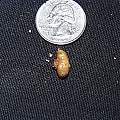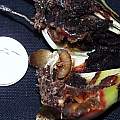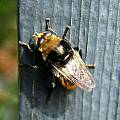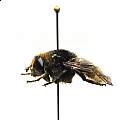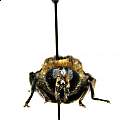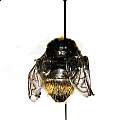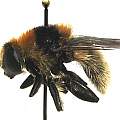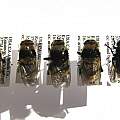Although called the Narcissus Bulb Fly, Merodon equestris, might better be called the amaryllid bulb fly or just the Bulb Fly. There are two flies: the large Narcissus Fly, Merodon equestris, and the small Narcissus Fly, Eumerus strigatus.
The large Narcissus Fly fly attacks a wide range of tunicate bulbs, in particular, Amaryllids: Hippeastrum, Lycoris, Narcissus, Nerine, Rhodophiala,Cyrtanthus, Paramongaia, Phaedranassa, Stenomesson, Galanthus, and others. For a picture follow this link on Mark Smyth's web page (via internet archive).
A single egg is laid at the base of the leaves during late spring/early summer where it hatches a few days later. The larva crawls down the leaf to the bulb where it normally enters through a hole it makes in the basal plate and begins to feed on the bulb. Although less common, the larva can enter the bulb through a hole it makes in the side of the bulb or through the very tip. Usually there is only one larva per bulb per season but more than one is not rare, especially if the daffodils are growing in heavy weed growth that restricts movement of the females. Since the larva enters the bulb and starts feeding near senescence, little above ground evidence of infestation is apparent during that season. By early fall, bulbs containing a larva will be soft and filled with a dense (more or less moist) brown to black excrement. At this stage, the grub is quite large (around 1 cm and fat), a dull rusty-red color and near immobile. During the winter, the grub remains within the destroyed interior of the bulb often positioning itself, facing upward, near the tip of the bulb in late fall. The following spring as the soil temperature warms, it emerges into the soil to pupate for two weeks and emerges as the adult fly. (It is often helpful in late fall to work the soil above daffodil plantings to seal the holes left by the previous season's foliage to make emergence of the adult fly difficult.) Males emerge first and go in search of a mate. Each female will lay some 15-20 eggs. Destruction of the central meristem of the bulb by the larva will often trigger the secondary meristem in the outer scales into growth (if the bulb is large enough; smaller bulbs are usually totally consumed). Thus, if the bulb is left in the soil, a number of small leaves will emerge the following spring. Three growing seasons later, the bulb will be large enough to bloom again and provide the food source for another generation.
One can rather easily remove the larva from infested bulbs later in the fall by gently probing through the entry hole with a hooked instrument or by a gentle squeeze on the bulb (the larva will pop out of the tip). Don't remove the detritus from the bulb. Plant the bulb as is since the detritus contains anti-fungicidal properties that prevent the bulb from rotting and enable it to survive long enough to aid sprouting of the surviving secondary meristem.
The first three pictures below showing a larva that has destroyed a Hippeastrum bulb were taken by Arnold Trachtenberg. The fourth was from David Fenwick showing the fly.
The series of photos below by Nhu Nguyen illustrate the morphological characters of these flies. These were collected in my garden buzzing around the bulb pots. They are mounted on pins. Photo 1 shows the side view of the fly. Notice the large antennae which is one of characteristic to separate Merodon and relatives from other group of flies. Photo 2 shows the front view which highlights the large eyes and golden hairs. Photo 3 shows the back side and the wings. The clear "C shaped" cell on the lower hind wing (and inverted C on the left) is a good character to identify this fly. Photo 4 shows a more detailed shot of the fly. It also shows the color variation in this species which is not quite diverse in the US as it is in Europe. Photo 5 shows the collection of flies which I caught on 2 warm May days. One of those days I caught 4! I cannot say how many more escaped on other warm days when I am not around, but at least 500 potential eggs were prevented from being laid. They are mounted as museum quality specimens.
Control is by spraying the base of the leaves several times during the season with Dylox (approved for use on Narcissus). Dursban (clorpyrifos) is also effective and may still be available for use in parts of the country other than Oregon where it is no longer approved for use. Both Dylox and Dursban are considered restricted pesticides in Oregon, requiring a pesticide license for purchase and application. The license is relatively easily obtained after coursework and testing. Imidacloprid may be helpful. Application of pesticides needs to be done before the fly becomes active in warm sunny weather as the pesticide must be in place on the leaf tissue between the soil surface and the bulb itself to insure the newly hatched larva is forced to contact it by crawling down to the base of the bulb. Remay or any floating row cover will give you a physical barrier to prevent the fly from laying its eggs on the foliage. When using physical barriers, one must be very careful to be certain all possible entry points are blocked because females can be very persistent in trying to reach the foliage. An additional benefit to something like Remay is that the adults tend to rest near the highest point during the night and can be easily seen and dispatched early in the morning. Dense planting near the bulb may also help to some degree. Another, very effective, option is to dig the bulbs annually and hot water treat the stocks. Dave Karnstedt describes this option in the following pbs list post. The unfortunate reality with daffodil fly is that the pest is endemic wherever tunicate bulbs are grown so whatever controls are being used, their effectiveness will last only one season.
The small Narcissus fly is less common. It lays a cluster of eggs that produces numerous maggots or larvae in each infested bulb. It is said to attack only bulbs that have been damaged in some way. However, I have encountered otherwise perfectly sound bulbs that have been attacked. During summer dormancy, the infested bulb deteriorates into a slimy black mush (the excrement) writhing with larvae; the bulb is a total loss and will not recover. While losses of this type are generally laid to the small narcissus fly, I'm not totally convinced that this is the case as fly larvae of many types complete the larval stage in rotting organic matter. Control as for the large fly.
Much of this information is courtesy of Den Wilson and Dave Karnstedt.
